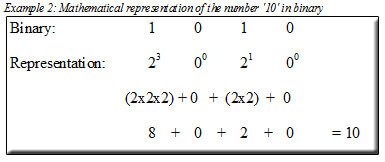Represent Numbers in Binary
August 2015 · 1 minute read
A binary number is a sequence of bits. Bits can either be on or off (1 or 0). If one bit in a binary code is switched from ‘on’ to ‘off’, it can affect the overall result of whole the code. Learn how to represent numbers in binary and understand what that means.

Binary numbers can be worked out by adding the sum of what each bit represents. Each ‘1’ bit represents a power of 2, and each ‘0’ bit represents 0.

While 4 bits make up one nybble of data, 8 bits typically make up one byte and usually represent a letter.

One full byte of data is the sum of 255

Words are often represented with 16 – 32 bits. The word ‘hello’ can be represented as 01001000-01000101-01001100-01001100-0100111

Two’s compliment is the negative notation of the binary representation of an integer and is the way every computer chooses to represent it’s integers. If the left-most bit in a piece of binary is ‘1’ then the number represented will be negative, if the left-most bit is ‘0’ then the number will be positive.

Key Sources:
- https://en.wikipedia.org/wiki/Binary_number
- http://www.mycomputeraid.com/networking-support/general-networking-support/howto-read-binary-basics/